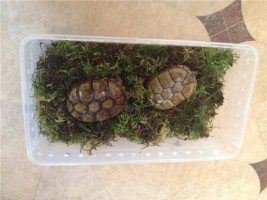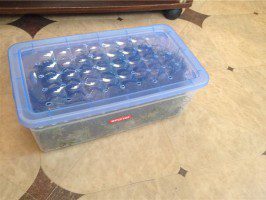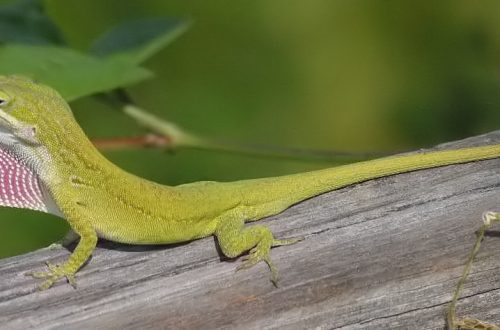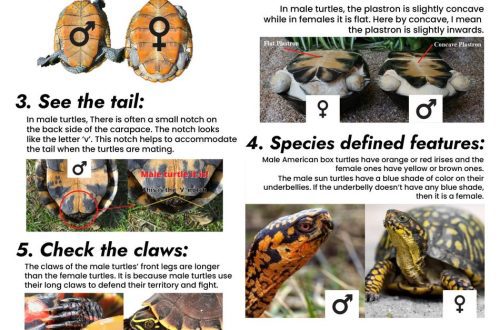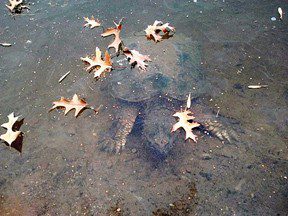
Turtle hibernation (wintering)

In nature, when it gets too hot or too cold, turtles go into summer or winter hibernation respectively. The turtle digs a hole in the ground, where it crawls and sleeps until the temperature changes. In nature, hibernation lasts approximately 4-6 months at least from December to March. The turtle begins to prepare for hibernation when the temperature in its habitat remains below 17-18 C for a long time, and when it exceeds these values for a long time, it is time for the turtle to wake up.
At home, it is very difficult to hibernate properly so that the turtle comes out of it healthy and comes out at all, so if you are new to terrariums, then we recommend that you do not hibernate turtles. Definitely do not hibernate sick animals and recently brought from somewhere.
Advantages of wintering: it helps to maintain the normal activity of the thyroid gland and thereby increase the lifespan of the turtle; it synchronizes the sexual activity of males and the follicular growth of females; it prevents overgrowth and helps maintain normal hormonal status. Both terrestrial and freshwater turtles can be hibernated.
Cons of wintering: the turtle may die or wake up sick.
What mistakes happen when organizing wintering
- Sick or weakened turtles are laid to winter
- Too low humidity during hibernation
- Temperature too low or too high
- Insects that climbed into the wintering container and injured the turtle
- You wake up turtles during hibernation, and then put them back to sleep
How to avoid wintering
In mid-autumn, turtles that overwinter in nature become less active and refuse to eat. If you do not want the turtle to hibernate and cannot provide it with normal sleeping conditions, then increase the temperature in the terrarium to 32 degrees, bathe the turtle more often. If the turtle will not eat, then you should go to the veterinarian and give a vitamin injection (Eleovita, for example).


How to put a turtle to sleep
European keepers strongly recommend hibernating turtles for their health. However, in the conditions of apartments, this is not at all easy. It is much easier to hibernate reptiles for those who have a private house. If, nevertheless, your goal is to put the turtle to sleep, or the turtle itself wants to go into hibernation (often sits in a corner, digs the ground), then:
- Make sure the turtle is a species that overwinters in the wild, so clearly identify its species and subspecies.
- You need to be sure that the turtle is healthy. It is better to consult with a veterinarian. However, it is not recommended to give vitamins and top dressing immediately before wintering.
- Before hibernation (end of autumn, beginning of winter), it is necessary to fatten the turtle well so that it gains a sufficient amount of fat that it needs to feed during sleep. In addition, the turtle should drink more.
- The land tortoise is bathed in warm water, then they are not fed for several weeks, but they are given water so that all the food eaten is digested (small 1-2 weeks, large 2-3 weeks). Freshwater turtles have their water levels lowered and also not fed for a couple of weeks.
- Gradually reduce the length of daylight hours (by setting the timer to shorter periods of turning on the lamps) and temperatures (gradually turn off the lamps or water heating) with an increase in humidity to the level required during the cooling period. The temperature should be lowered smoothly, since too sharp a decrease in it will lead to colds.
- We are preparing a wintering box, which should not be too large, because. during hibernation, turtles are inactive. A plastic container with air holes will do. Wet sand, peat, sphagnum moss 10-30 cm thick are placed at the bottom. Turtles are placed in this box and covered with dry leaves or hay on top. The humidity of the substrate in which the turtle hibernates should be high enough (but the substrate should not get wet). You can also place turtles in linen bags and pack them in foam boxes, in which sphagnum or sawdust will be loosely thrown.


- Leave the container at room temperature for 2 days.
We put the container in a cool place, for example, in a corridor, preferably on a tile, but so that there are no drafts.
В
depending on the type and the temperatures required by it, we lower the temperature, For example: floor (18 C) for 2 days -> on the windowsill (15 C) for 2 days -> on the balcony (12 C) for 2 days -> in the refrigerator (9 C) for 2 months. The place for wintering turtles should be dark, well ventilated, have a temperature of 6-12°C (preferably 8°C). For exotic southern tortoises, dropping the temperature by a couple of degrees may be enough. It is necessary every time, examining the turtle, at the same time spray the soil with water. It is better to do this every 3-5 days. For aquatic turtles, the humidity during hibernation should be greater than for land turtles.
- It is necessary to bring out of hibernation in the reverse order. Before letting the overwintered turtles into the terrarium or outside, they are bathed in warm water. If the turtle appears dehydrated, emaciated, inactive, or in a daze, recovery efforts should begin with warm baths.
- Normally, the turtle should begin to feed within 5-7 days after the normal temperature is established. If the turtle is unable to recover, contact the veterinarian.
It is important to know
Hibernation time for turtles is usually 8-10 weeks for small turtles and 12-14 for large turtles. It is necessary to put the turtles in wintering in such a way that they “woke up” no earlier than February, when daylight hours noticeably lengthen. Can be from 3-4 weeks to 3-4 months. The condition of the turtles is checked every month, trying not to disturb them. The mass of a turtle normally decreases by 1% for each month of wintering. If the weight decreases faster (more than 10% of the weight) or the general condition worsens, wintering should be stopped. It is best not to bathe turtles during the winter, as they usually urinate if they feel water on the shell. If the turtle began to show activity at a temperature of 11-12 ° C, wintering should also be stopped. For all hibernating reptiles, the limits of temperature fluctuations are from +1°С to +12°С; in the case of long-term cooling below 0 ° C, death occurs.
(the author of some of the information is Bullfinch, myreptile.ru forum)
Gentle hibernation for turtles
If the general condition of the turtle does not allow for a full-fledged wintering, or if there are no suitable conditions in the apartment, you can arrange a “overwintering” in a gentle mode. To do this, soil is introduced into the terrarium in which the turtle was kept, which better retains moisture (sawdust, moss, peat, dry leaves, etc.). Level – 5 – 10 cm. The soil should not get wet. The light in the terrarium can be turned on for 2 to 3 hours a day. In the middle of “overwintering” the light can be completely turned off for 2 – 3 weeks. The temperature should be maintained at 18-24°C during the day and fall to 14-16°C at night. After the “peak” of such wintering (when the heating is turned on again for 2-3 hours), you can offer the turtle its favorite food once a week. The beginning of self-feeding is a signal of the end of wintering.
(from D.B. Vasiliev’s book “Turtles…”)
Wintering temperature of different species of turtles
K.leucostomum, k.baurii, s.carinatus, s.minor – room temperature (you can put it somewhere on the floor, where it’s cooler) K.subrubrum, c.guttata, e.orbicularis (marsh) – about 9 C T.scripta (red), R.pulcherrima – do not need hibernation
Articles on the site
- Advice from foreign experts on the correct WINTERING of turtles
© 2005 — 2022 Turtles.ru



